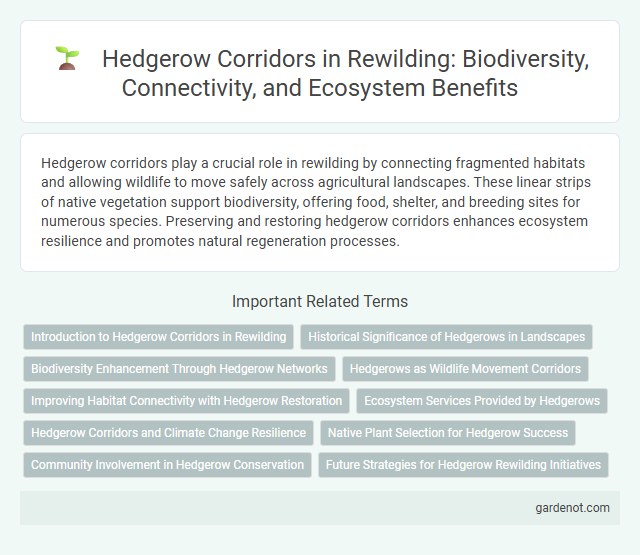Hedgerow corridors play a crucial role in rewilding by connecting fragmented habitats and allowing wildlife to move safely across agricultural landscapes. These linear strips of native vegetation support biodiversity, offering food, shelter, and breeding sites for numerous species. Preserving and restoring hedgerow corridors enhances ecosystem resilience and promotes natural regeneration processes.
Introduction to Hedgerow Corridors in Rewilding
Hedgerow corridors serve as critical ecological networks that connect fragmented habitats, enabling wildlife movement and promoting biodiversity in rewilding projects. These linear strips of native shrubs, trees, and grasses act as natural pathways for pollinators, birds, and small mammals, enhancing ecosystem resilience. Established hedgerows improve soil health, support carbon sequestration, and contribute to landscape-scale habitat restoration.
Historical Significance of Hedgerows in Landscapes
Hedgerow corridors have shaped rural landscapes for centuries, serving as vital boundaries for agricultural land and providing habitats for diverse wildlife species. Historically, these dense, linear plantings marked property lines and facilitated livestock management while promoting ecological connectivity between fragmented habitats. Preservation of hedgerows retains cultural heritage and supports biodiversity by maintaining corridors essential for species movement and genetic exchange.
Biodiversity Enhancement Through Hedgerow Networks
Hedgerow corridors serve as vital biodiversity hotspots, providing continuous habitats that support a wide range of flora and fauna. These linear networks facilitate species movement, gene flow, and ecological connectivity, crucial for ecosystem resilience and wildlife conservation. Enhancing hedgerows with native plants and structural complexity significantly boosts pollinator populations and bird diversity, strengthening overall landscape biodiversity.
Hedgerows as Wildlife Movement Corridors
Hedgerow corridors serve as vital wildlife movement pathways, linking fragmented habitats and enabling species to migrate safely across agricultural and urban landscapes. These dense, linear plant structures offer shelter, food resources, and breeding sites, supporting biodiversity by facilitating gene flow and reducing isolation of animal populations. Effective management of hedgerows enhances ecological connectivity, promoting ecosystem resilience and aiding in the rewilding process.
Improving Habitat Connectivity with Hedgerow Restoration
Hedgerow corridors enhance habitat connectivity by linking fragmented ecosystems, allowing wildlife to move safely across agricultural and urban landscapes. Restoration of native hedgerow species increases biodiversity, providing food, shelter, and breeding grounds for pollinators, birds, and small mammals. Continuous hedgerows also act as ecological stepping stones that facilitate gene flow and species dispersal, crucial for resilient and healthy wildlife populations.
Ecosystem Services Provided by Hedgerows
Hedgerow corridors enhance biodiversity by providing critical habitats and food sources for pollinators, birds, and small mammals, which support ecosystem stability. They improve soil health through nutrient cycling and prevent erosion by stabilizing the land with deep-rooted plants. Hedgerows also regulate microclimates, contribute to carbon sequestration, and filter pollutants, improving air and water quality within agricultural landscapes.
Hedgerow Corridors and Climate Change Resilience
Hedgerow corridors serve as vital ecological pathways that enhance climate change resilience by facilitating species migration and genetic exchange in fragmented landscapes. These linear habitats help regulate microclimates, improve soil carbon sequestration, and reduce erosion, contributing to ecosystem stability amid changing weather patterns. Maintaining and restoring hedgerow networks supports biodiversity and strengthens natural adaptive capacities to withstand climate-induced stresses.
Native Plant Selection for Hedgerow Success
Selecting native plant species for hedgerow corridors enhances biodiversity by providing essential habitats and food sources for local wildlife. Native plants are adapted to regional soil and climate conditions, increasing the hedgerow's resilience and growth success. Incorporating a diverse mix of native shrubs, trees, and groundcover promotes ecological connectivity and supports pollinators critical for ecosystem health.
Community Involvement in Hedgerow Conservation
Community involvement plays a crucial role in hedgerow conservation by fostering local stewardship and enhancing biodiversity corridors. Volunteer activities such as planting native species, monitoring wildlife, and maintaining hedgerow health directly contribute to habitat connectivity and ecosystem resilience. Engaged communities help sustain hedgerow corridors as vital pathways for wildlife movement and genetic exchange across fragmented landscapes.
Future Strategies for Hedgerow Rewilding Initiatives
Future strategies for hedgerow rewilding initiatives emphasize enhancing biodiversity through native plant restoration and promoting habitat connectivity for wildlife corridors. Integrating advanced monitoring technologies and community engagement programs supports adaptive management and long-term ecosystem resilience. Strategic partnerships with agricultural stakeholders aim to balance conservation goals with sustainable land use, fostering widespread adoption of hedgerow rewilding practices.
Hedgerow corridor Infographic

 gardenot.com
gardenot.com